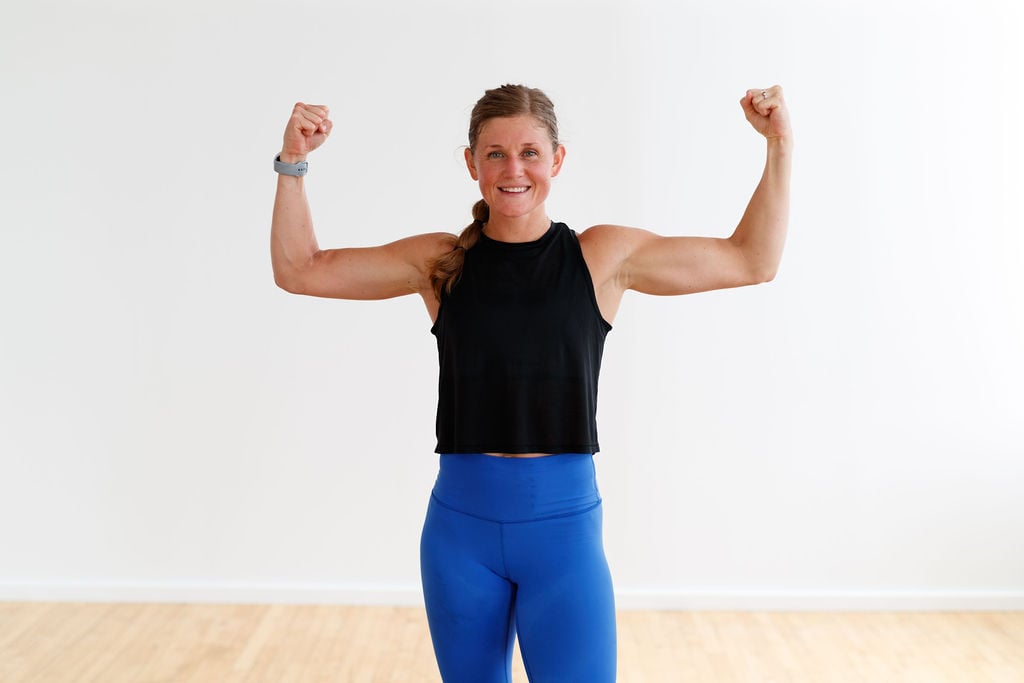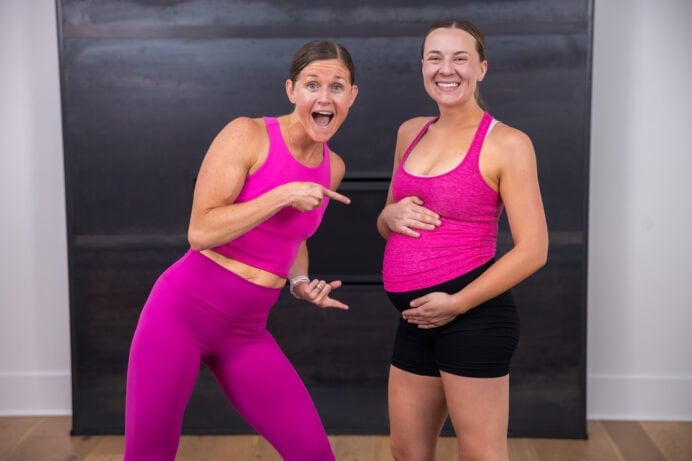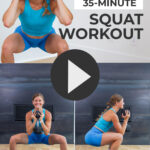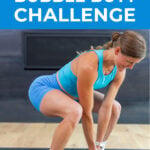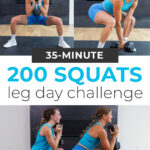

30-Minute Squat Workout
Build strong legs at home with this squat workout. We’ll perform eight different squat exercises in a strict set, back to back. Between each circuit, we’ll perform 20 repetitions of another squat variation (completing over 200 squats in this workout). Target the quads, hamstrings, glutes, calves and thighs in this dumbbell workout.
Complete over 200 squats at home with this 30-minute squat workout.
Foundational moves are key to building strength and maintaining proper form. Today’s workout focuses on one of the best foundational lower body exercises: the SQUAT.
Squats are a great fundamental exercise. Any time you bend down to pick something off the ground, you’re squatting. It’s important to train this movement to ensure you’re able to move pain-free in your daily life.
And because you loved the strict set format we took to our chest workout and shoulder workout, we’re bringing the same format to leg day. We’ll hit muscle fatigue with the strict set format and add a set of squat variations between each exercise for good measure (you’ll perform 16 squat variations in today’s workout).

30-Minute Squat Workout
Build lower body strength with this 30-minute squat workout.
A complete workout targeting every muscle group in the lower body: the quads, hamstrings, glutes, calves, and thighs.
Add this leg workout to your home workout plan 1-2 times per week to build and maintain strength in the lower body.
Workout Equipment:
Medium to Heavy Set of Dumbbells. I recommend between 5-30 lbs depending on your fitness level. We used 15, 20 and 30 lb dumbbells in today’s workout. Option to drop weights at any time and do this workout with just your body weight.
Option to add a mini loop resistance band (discount code: NML) and/or plyo box (or sub a bench/chair).
Workout Instructions:
Follow along with the guided Squat Workout on YouTube, led by certified personal trainer, Lindsey Bomgren.
Your Workout Looks Like This:
- 8 Leg Exercises
- Timed Intervals (40 seconds of work per exercise, followed by 20 seconds of rest)
- Strict Sets (repeat each leg exercise x 2 sets, back-to-back)
- Perform 20 Reps of Squat Variations After Each Leg Exercise
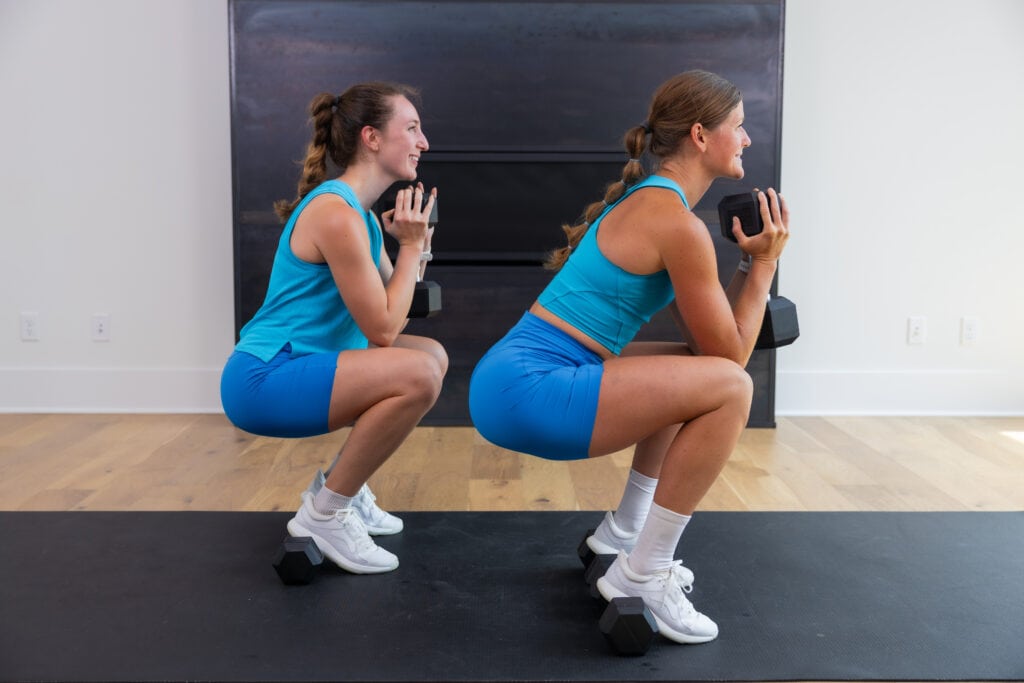
Prefer to Watch On YouTube?
Workout Outline
- 80/20 Squat
- Sumo Squat
- Lateral Squat
- Bulgarian Split Squat
- Heel Elevated Squat
- Kang Squat
- Single Leg Squat to Box
- Glute Focused Squats
8 Squat Exercises
80/20 Squat
Targets: Legs, glutes, quads, hamstrings, hip flexors and core.
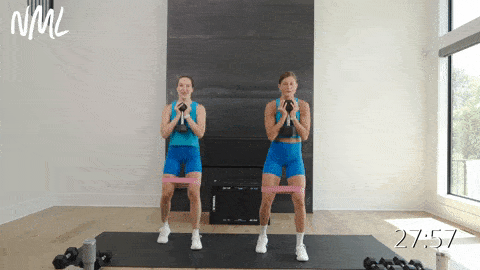
How To Do An 80/20 Squat
- Stand with feet hip-width apart, knees slightly bent. Option to place a resistance band six inches above your knees. Hold one dumbbell vertically at your chest in a goblet-hold.
- Stagger your feet, so your left leg is slightly in front of your right foot. Kickstand your back right foot, right heel floating off the ground. Keep 80% of your weight in your front foot, 20% in your back right toe.
- Maintain a staggered stance as you perform a squat, lowering down into a squat position until hips are parallel with your knees. Drive your knees out toward your outer three toes.
- Drive through your front left heel to stand tall, squeezing your glutes and repeat.
Sumo Squat
Targets: Legs, glutes, quads, hamstrings, hips, outer thighs and glutes (gluteus medius and abductors) and inner thighs (adductors).
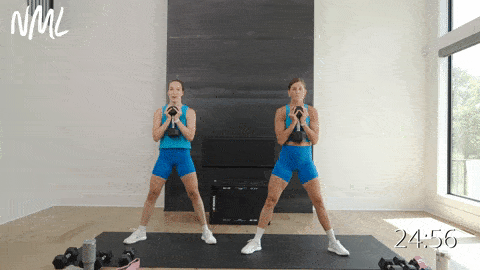
How To Do A Sumo Squat
- Stand with feet wider than hips, heels in and toes pointed out (sumo squat stance). Hold one dumbbell at your chest (or two dumbbells between your legs).
- Bend your knees to lower down into a sumo squat, pushing your knees out towards your pinky toes as you drop your hips parallel to your knees.
- Drive through your heels, squeezing your glutes and pulling your inner thighs together to stand tall.
Lateral Squat
Targets: Gluteus medius (outer glute that controls hip movement and side-to-side movements), quads, inner thighs (or hip adductors), hamstrings and calves.

How To Do A Lateral Squat
- Start with your feet wider than your hips (think a wide squat stance), with your knees and toes pointing forward. Or toes just slightly turned out away from your body.
- Hold one dumbbell at your chest like you would during a goblet squat (vertically so dumbbell is touching your collarbone and sternum), elbows tucked in.
- Shift your weight into your right heel as you push your hips back, bending your right knee while leaving your left leg straight. Think of performing a single leg squat with your right leg while your left leg remains straight.
- Then, drive through your right foot to reverse the movement, pushing you back up to center.
- Then shift your weight into your left heel as you push your hips back, bending your left knee while leaving your right leg straight.
- Repeat for the timed interval, alternating the leg that performs a lateral squat.
Bulgarian Split Squat
Targets: Legs, glutes, quads, hamstrings, hips and core.
This single leg exercise will challenge your balance and has been named one of the best exercises to build glute strength.

How To Do A Bulgarian Split Squat
- Kneel in front of your bench or chair, then place your left foot behind you on a chair or bench, shoelaces down. Hold a dumbbell in your left hand.
- Step your right foot forward (it will vary for everyone, but a little over a foot in front of your bench). Your front thigh will be parallel to the floor. This is the bottom of your movement.
- Drive through your front right heel, squeezing your right glute to return to standing. Feel your front glute engage to power the movement.
- With control, bend your knee to lower down back to the starting position (back left knee should lower down close to the ground), to make your front thigh parallel with the ground. Shoulders remain stacked over hips throughout the movement.
Modification: Perform a standard reverse lunge or split squat, keeping your back foot on the ground rather than elevating it on a chair.
Heel Elevated Squat
Targets: Legs, quads, glutes, hamstrings, inner thighs (hip abductors), chest and core.
Raising your heels allows you to get deeper range of motion in your squat.
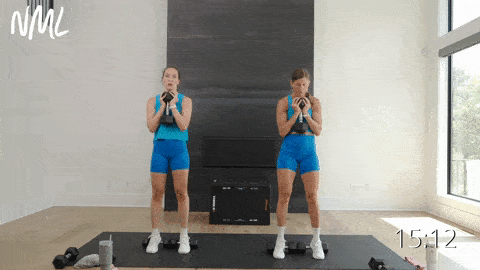
How To Do Heel Elevated Squats
- Place a set of dumbbells on the ground behind your feet. Stand with your feet hip width apart, placing your heels on the bar of each dumbbell. Hold one dumbbell vertically at your chest like you would during a goblet squat. Engage your core.
- Inhale as you bend your knees and sit your hips back (as if sitting down in a chair). Aim for 90 degree bends at each knee, focusing on pushing your knees out (not letting them cave in). Keep your torso in an upright position.
- Exhale as you press through your heels to stand tall, driving your hips forward to return to standing position.
Modification: Perform this move with feet flat on the floor if heels raised isn’t comfortable for you.
Kang Squat
Targets: Glutes, hamstrings, quads, erector spinae, lower back and core muscles.
The Kang Squat is a deadlift and squat combination that provides a great way to improve your hip-hinge form while also challenging the posterior chain.

How To Do A Kang Squat
- Start in a standing position, feet hip-width apart or slightly wider, core engaged. Place one dumbbell, horizontally, on your upper back, neck and shoulders. Holding each head of the dumbbell with one hand.
- With a slight bend in your knees, hinge forward at the hips until your torso is parallel to the ground (this is a good morning). Core is engaged and spine is neutral (back flat). You should feel a stretch in your hamstrings (back of the legs) at the bottom of the movement.
- Then lower down into a squat, pushing your hips back and down until your hips align with your knees (making a 90-degree angle with your hips and knees). Knees push out towards your outer three toes.
- Reverse the movement, driving through your heels to stand halfway, returning to the bottom of the good morning position (back flat), then fully stand tall, returning to the starting position (torso upright).
Single Leg Squat to Box
Targets: Legs, glutes, quadriceps (thighs), hamstrings and core.

How To Do A Single Leg Squat to Box
- Start standing in front of your box or bench, feet shoulder-width distance apart, knees slightly bent, core engaged. Hold a dumbbell horizontally between both hands at your collarbones.
- Shift your weight into your right foot to find a balance position.
- Lower down into a squat position, lowering your hips down to tap your glutes to the box behind you. Both knees bent at 90 degrees, left foot raised off the ground.
- Drive through your right heel to stand tall, squeezing your glutes. Maintain the balance element, keeping the left foot raised off the ground.
Modification: Option to omit the single leg squat and perform a staggered squat to box.
Glute Focused Squats
Targets: Glutes, quads and hamstrings.

How To Do Glute Focused Squats
- Stand with your feet shoulder width apart. Hold one dumbbell vertically with both hands, dumbbell hanging slightly in front of you.
- With a slight bend in your knees, hinge forward at the hips until your torso is parallel to the ground. Core is engaged and spine is neutral (back flat). You should feel a stretch in your hamstrings (back of the legs).
- Maintain this forward hinge as you lower down into a squat, pushing your hips down until your hips align with your knees (making a 90-degree angle with your hips and knees). Knees push out towards your outer three toes. If possible, tap the dumbbell to the ground.
- Drive through your heels to stand as you continue to maintain the forward hinge. To make this exercise harder, keep constant tension on the glutes by never standing straight up, keeping a slight bend in the knees.
Squat Workout FAQs
Squats target all the lower body muscles like the glutes, quads, hamstrings, thighs and hips. A strong lower body can improve your posture and balance, and help protect your knees, hips and lower back.
Muscular hypertrophy, or muscle growth, is reached through a combination of load (or weight) and volume (or reps performed). In order to grow your glutes, you need to progressively overload the muscle by increasing load or volume over multiple weeks. Squats are an effective exercise in glute workouts for women.
Squats are a solid foundation for training and an exercise you can come back to if you experience pain while lunging. While squats are great for both beginners and advanced athletes, I recommend including a variety of lower body exercises to challenge your strength and muscular endurance. A well-rounded workout plan will include upper body workouts and full body workouts, in addition to lower body workouts.
Ankle and hip mobility are key to getting deeper squats and improving squat form. If you feel your squat form is suffering, consider lessening the weight you’re using or performing bodyweight squats. You can also loosen tight hips with this hip flexor stretch routine.
More Workouts
Leg WorkoutsPin This Workout: 30-Minute Squat Workout

This post includes affiliate links. I do earn a commission for products purchased using these links (at no additional cost to you). Thank you for supporting Nourish Move Love, making the content you see on this blog possible.










